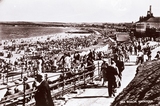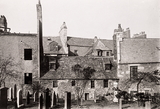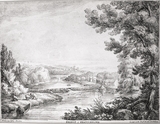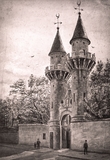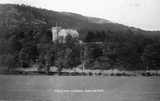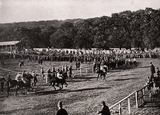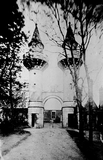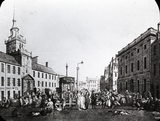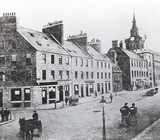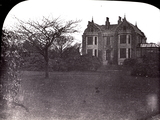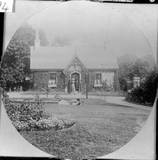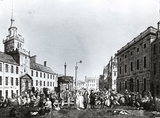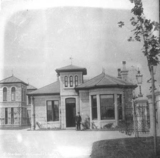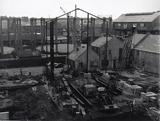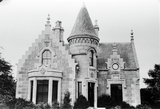|
Quick Search
|
Search Results
You searched for: More Like: 'Lodge Walk'
134 items
items as
Aberdeen Sea Beach
51 The Promenade at Aberdeen Sea Beach, c. 1950 with the Beach Shelter and Beach Bathing Station in the background. Gateway to Bridewell Prison
54 Gateway to Bridewell Prison, Rose Street, c.1880 - this massive gateway was the impressive entrance to the Bridewell in Rose Street, situated off the west end of Union Street. The Bridewell was opened in 1809 as a House of Correction and became known as the West Prison. It was in use till 1868, when it was closed and later demolished. For a short while, the site was laid out as the West End Pleasure Gardens and Recreation Grounds. The gateway had a porter's lodge and a guardhouse attached and it remained until 1883, when it was demolished to allow Rose Street to be extended northwards to link with Henry Street which in turn led on to Skene Street. Henry Street had been named after George Henry, Provost of the City between 1850-53 but the whole street then became known as Rose Street. Old Aberdeen
71 A reproduced engraving showing the skyline of Old Aberdeen. The image looks north from around the lands of Sunnyside Farm.
In the foreground can be seen two agricultural labourers. On the skyline, going left to right, is the circular Powis Hermitage, on a hill, with its small spire, the twin spires of St. Machar Cathedral in the far distance, the tower of the Old Town House at the end of the High Street, which is protruding above the southern elevation of St. Mary's United Free Church.
Moving back along the High Street, the south facing front elevation, with bow windows, of Powis Lodge can be seen above the line of trees. The crown tower of King's College is across the street. The two minarets of the Powis Gateway are just next to it. Further along are the crenelations of Cromwell's Tower.
The tower on the far left of the image may be Dunbar's Tower.
The minaret gateway was finished in 1834 and this image likely dates from around that period. Schoolhill from St. Nicholas Churchyard
120 This photograph taken in 1880 from St. Nicholas Churchyard looks north showing a row of houses which stood between it and Schoolhill.
These houses were demolished around 1884 as part of an improvement scheme to widen Schoolhill - named after the old Grammar School which stood nearby.
A dwarf wall with ornamental railings was erected in place of these buildings and a porter's lodge was removed from Robert Gordon's College to form a lodge for the sexton at the entrance to the churchyard.
The book Aberdeen in Byegone Days: Views of Streets and Buildings, etc. with Letterpress Description (1910) by Robert Anderson (page 26) suggests that the building in the centre of this image was the home of Burnett Carr, the grave-digger and assistant to the sexton of St. Nicholas Church.
Newspaper references indicate that Carr, a well known figure, died on 31st May 1844 (Aberdeen Journal, 5th June 1844, page 3, column 2).
This photograph looks north and shows the back of Carr's old house. Bridge of Grandholme
160 An engraving showing Grandholm Bridge over the River Don from a drawing by James Giles. The inscription in the bottom right indicates that the engraving was printed at the Deaf and Dumb Institution.
This drawing likely looks west up the river and in the middle distance shows the Cruive Dikes, a complex of weirs and sluices across the River Don built for the purpose of fishing. Remains of these are located not far to the east of the modern Diamond Bridge.
Some information on the ownership and operation of the cruives is given in the book The Annals of Aberdeen (Volume II, 1818) by William Kennedy, on pages 207-209.
In the far distance is Grandholm Bridge. Aberdeen City Council's Historic Environment Record states that the bridge was built by the firm of Leys, Masson and Company in 1810 to improve access to its Granholm Works. It was a wooden bridge with a small lodge and was known locally as the "White Bridge."
The 1810 bridge was replaced by the present steel structure, built by the Motherwell Bridge Company, in 1922. Powis Gateway, Old Aberdeen
162 Powis Gateway, Old Aberdeen. These curious towers stand at the gate leading to Powis Lodge, almost opposite King's College, Old Aberdeen. They were constructed by John Leslie of Powis, who succeeded his father, Hugh Leslie of Powis, the builder of Powis House (1802). John Leslie succeeded his father in 1812, and the singular gateway, with the "minarets", dates from about 1830. The towers were finished in 1834. The crescent on the top of one of the towers is the crest of the Frasers, the predecessors of the Leslies in the property of Powis. Powis Gateway, Old Aberdeen
165 Powis Gateway, Old Aberdeen. These curious towers stand at the gate leading to Powis Lodge, almost opposite King's College, Old Aberdeen. They were constructed by John Leslie of Powis, who succeeded his father, Hugh Leslie of Powis, the builder of Powis House (1802).
John Leslie succeeded his father in 1812, and the towers were finished in 1834. The crescent on the top of one of the towers is the crest of the Frasers, the predecessors of the Leslies in the property of Powis.
As indicated in the bottom right, this etching of the gateway is by Aberdeen artist Henry Jackson Simpson (1893-1963), known professionally as Jackson Simpson. He was a prolific and successful local artist who specialised in etchings and watercolours of architecture, land and seascapes and wildlife.
Simpson died at his home at 58 Craigton Road, aged 70, on 28th March 1963. His obituary, which gives an account of his life, featured in the next day's Press & Journal.
He was a native of Aberdeen, the son of William Jackson, an art dealer in Diamond Street. He trained as a lithographer and joined his father in business. He served in WWI with the Northumberland Fusiliers and was awarded the Military Cross for bravery.
In 1935 he took over the family business following the death of his father. He was well travelled around Aberdeenshire and Kincardineshire and this is reflected in his art. University related subjects such as Marischal College, King's College and, here, the Powis Gateway, were among his most well known works.
A keen sportsperson, and prominent freemason, he also set-up the Craigton Club and was highly involved with the Northern Arts Club.
An article titled 'The charming story of Jackson Simpson: Scotland's celebrated etcher' featured on the Press & Journal website, in partnership with the McEwan Gallery near Ballater, on 8th June 2022. The feature was produced to highlight an exhibition of Simpson's work at the aforementioned gallery. Seaton Park Racecourse, 1928
259 This image shows one of the last races in Seaton Park at a meeting held on Saturday 22nd and Monday 24th September 1928.
Horse racing had taken place in the city regularly in the 19th century when there was a racecourse at the Links. Its popularity had declined but racing was revived in Seaton Park in 1923 when 30,000 people attended.
The 1928 Meeting was not a great success since less than 1000 spectators attended on the Saturday, although 3000 attended on the Monday despite intermittent rain. The entrance fee to the ground was 1/6 (seven and a half pence) and to the Paddock 4 shillings (20p) with licensed bars, refreshments and teas available.
The fields were not large with only 5 runners in the main events. The Bon Accord Handicap, run over 7 furlongs, had prize money of 25 sovereigns. The last race on the Monday was the Consolation Handicap (for beaten horses). Only 3 horses ran, with "Lolita" winning by 6 lengths. The third horse "Peggy Maitland" was so far behind that her owner/jockey had to walk her past the post.
An application made in 1956 to restart horse racing was turned down by the Town Council. Gateway to Powis Lodge
654 Built in 1834 for John Leslie of Powis by Alexander Fraser, the towers formed the east gate and archway from College Bounds, Old Aberdeen.
These oriental style towers with minarets have provoked much interest over the years. At one time there was a portrait of John Leslie dressed in Turkish costume, on the walls of Powis House, but there is no obvious connection between the estate and the Middle East. The gateway is also adorned with panels bearing the coats of arms of the Lairds of Powis.
The Estate of Powis was owned by the Frasers - their crest is shown on the towers - until the marriage of an heiress to a Leslie. Powis House was built by Hugh Leslie. By the late 19th century it was owned by the Burnett family and was taken over by Aberdeen City Council in the 1930s and converted into a community centre. Seaton's view of Castle Street
670 This view was drawn by Robert Seaton in 1806. On the left is the Tolbooth and adjoining it is the Mason Lodge and New Inn. The property was sold in 1839 to the proprietors of the North of Scotland Bank and the bank offices were erected on the site in 1840-2. In the late 1990s, the bank closed and became a pub, called Archibald Simpson's, after the original architect. The prominent building on the right side was the Aberdeen Bank, later to become the Bank of Scotland building. The tall man in the centre was John Ewen, jeweller, the man on the right with the drum was Watty Leith, Town Drummer, and on the left is John Milne, the Town Hangman, talking to the fishwives, claiming his free fish as perks of his trade. Castle Street
673 A view of the buildings at Castle Street prior to their demolition for the construction of the new Town House (1867-1874) designed by Peddie and Kinnear.
The entrance to Broad Street is visible in the left foreground. The entrance further on is to Huxter's Row, which turned west and ran behind these building to exit on Broad Street. The Lemon Tree Hotel and the Bon-Accord Hotel were located on this lane. The former soon moved to 7-9 St. Nicholas Street.
Past the fortified facade of the Tolbooth, and its prominent spire, can be seen the entrance to Lodge Walk and Archibald Simpson's North of Scotland Bank premises, opened in 1842.
The signs in the shop windows likely give notice of imminent closure. A sign for Alexander Badenoch, an outfitter, can be seen at 12 Union Street. Further down, at what is likely Chapman and Co., tailors and clothiers, "Great bargains" are advertised.
In addition to the gas lamps and pollards, there is array of traffic on the cobbled street. Two night watchmen stand talking on the left. A Gordon Highlander, presumably coming from the nearby Castlehill Barracks, is outside Badenoch's shop. Two fishwives carry leaden creels to market. A large dog sleeps outside Chapman and Co. and various horse drawn vehicles are shown. Castlegate looking west
674 Drawing of Castlegate looking west along Union Street.
Correspondent Ed Fowler got in touch to point out the salient features of "the Plainstones, Mercat Cross in is original position with the Athenaeum Reading Room, Tolbooth, the New Inn (Freemasons Lodge) and the Aberdeen Bank at the top of Marischal Street.
It is one of set of 3 drawings by the same artist employed by Gibb's the Lithographer. The others being the Brig o' Dee, and the Nether Kirk Gate, Benholm Lodging." Wallfield House
724 Wallfield House probably dated from the 18th century but, in a sale advert in 1826, it is referred to as the "property of Wallfield, formerly called Lower Belvidere ... within 15 minutes walk of the Castle Street of Aberdeen".
It was situated in the Rosemount area, had 20 rooms with "2 acres of fine rich land surrounded by a high wall, covered with fruit trees of the finest kinds!"
It was owned by Robert Catto, shipowner in the Australian and China trade, and a member of Aberdeen Harbour Board. After his death in 1885, and that of his widow in 1897, the house was demolished and the grounds laid out as two streets: Wallfield Place and Crescent. Watson Street Lodge
733 A photograph of the Watson Street Lodge in Victoria Park.
The figures standing in the doorway are most likely to be Robert Walker (1848-1930), the Keeper of Victoria Park, and his family; his second wife Christina Walker and daughters Elizabeth and Ann. Judging by the 1891 census and Robert's eventual obituary, the family also had at least five sons.
Walker was previously married to Isabella Robertson. She died on 24th November 1877. This photograph likely dates from the later 19th century.
Robert Walker was originally from Perth and was himself a son of a gardener. He came to Aberdeen as a nurseryman and in around 1871 was chosen out of 450 candidates to be the city's first keeper of parks.
He oversaw the creation of Victoria Park, Aberdeen's first public park, before going on to lay out Westburn Park, Stewart Park, Union Terrace Gardens and the Promenade. Walker was also an early advocate and pioneer of the planting of street trees.
For a number of years Aberdeen had two superintendents of parks, Walker and a Mr Peter Harper at Duthie Park. When Harper retired in 1914 Walker was appointed general superintendent.
Post Office directories indicate that Walker and his family lived at the Watson Street Lodge, also known as the Victoria Park Lodge, from its construction in around 1872 to his retirement in 1919. His residence at the lodge was part of the job. On retirement Walker moved to the relatively nearby 111 Westburn Drive.
He was succeeded as general superintendent of parks by William B. Clark, who resided at the West Lodge of Duthie Park. A man called Robert Duncan replaced Walker as the keeper of Victoria and Westburn Park.
Over the years Aberdeen has had substantial success and renown as an attractive, green city. A considerable portion of the credit for this success must reside with the pioneering and dedicated work of Robert Walker. Seaton's view of Castle Street
746 This view was drawn by Robert Seaton in 1806. On the left is the Tolbooth and adjoining it is the Mason Lodge and New Inn. The property was sold in 1839 to the proprietors of the North of Scotland Bank and the bank offices were erected on the site in 1840-2. In the late 1990s, the bank closed and became a pub, called Archibald Simpson's, after the original architect. The prominent building on the right side was the Aberdeen Bank, later to become the Bank of Scotland building. The tall man in the centre was John Ewen, jeweller, the man on the right with the drum was Watty Leith, Town Drummer, and on the left is John Milne, the Town Hangman, talking to the fishwives, claiming his free fish as perks of his trade. Aberdeen City Hospital lodge
805 Aberdeen City Hospital lodge, Urquhart Road. The hospital was built as a fever hospital in 1874 but is now used for elderly patients. Wellington Lodge
811 A photograph showing Wellington Lodge on the corner of Justice Mill Lane and Holburn Street.
The top of Holburn Street, towards Holburn Junction, was previously known as South Street and later as Wellington Place. In the background of this image, on the far left, can be seen the John Smith designed Water House on Union Street.
Wellington Lodge stood across the road from Holburn Church, roughly where the Glentanar Bar stands today. It can be seen on the large scale Ordnance Survey town plan and map sheets from the 1860s.
The property appears to have belonged to the Whytes of Dalhebity, Cults. For some time Wellington Lodge was the residence of Helen Whyte and she was likely the house's final resident.
Helen Whyte died aged 85 on 31st January 1898 (death notice: Aberdeen Weekly Journal, 09/02/1898, p. 4). Newspaper references suggest she was involved in various charitable activities. She was the daughter of Baillie John Whyte, a merchant, and had a brother also called John Whyte (1845-1904), a prominent citizen and advocate.
Another death notice indicates that Mary Ann Hardie, of 48 Victoria Road, Torry, was employed for 38 years as the servant for Miss Helen Whyte. Hardie died in 1895 (death notice: Aberdeen Journal, 17/08/1895, p. 4).
Newspapers also suggest the villa was the home of Miss Mary Murray Gordon. She would likely have been a relation of James Murray Gordon who was a partner in the same law firm as John Whyte, Helen's aforementioned brother.
Wellington Lodge was probably demolished shortly after the death of Helen Whyte. It made way for the extension of the larger tenement buildings on Holburn Street that can be seen in the background of this photograph.
The Aberdeen Weekly Journal's 'Granite Chips' column of 17th May 1899 (p. 9) states "A very large and handsome block of buildings for Mr Peter Farquharson has been erected in Holburn Street, stretching from the office of the Union Bank of Scotland to Justice Mill Lane." This most likely refers to this development.
David Miller in Archibald Simpson, Architect, His Life and Times 1790-1847 (2006) states that this villa was designed by Simpson for Mrs Yeats of Auquharney (page 174). Sandilands Chemical Works
845 Foundation work for the new granulation plant, Sandilands Chemical Works. In the background are the old lodge buildings which became laboratory and office buildings in the later history of Sandilands. The granular fertiliser produced by the new plant was based on ammonium phosphate and as such was a more concentrated chemical fertiliser than that produced on superphosphate base. The batch mixer was replaced by a continuous mixer and the plant produced approximately 20 tons per hour, 24 hours a day, every day. Great Southern Road
859 In 1880, Miss Elizabeth Crombie Duthie of Ruthrieston bought land at Allenvale and Polmuir and the vacant estate of Arthurs Seat and donated it to Aberdeen Town Council as a public park. Today, the park covers 44 acres of wide open spaces. A restaurant was also opened in 1972 at a cost of £50,000 and the famous winter gardens built in 1899 at a cost of 1550 pounds and subsequently rebuilt in 1969 at a cost of £58,000. In the centre of the picture can be seen the old West Lodge or Duthie Lodge. When the Great Southerrn Road and King George VI Bridge were built in 1938, the lodge was bought for 60 pounds by an Aberdeen contractor, dismantled and moved piece by piece to Rubislaw Den South. The Great Southern Road was a new road from Holburn Street to Whinhill Road, linking the city with the new satellite town at Kincorth and onwards to meet the Aberdeen - Stonehaven Road. Culter
876 This image was taken around 1909 from a hill at the west end of Culter - 7 miles west from Aberdeen looking down on the North Deeside Road towards Banchory. The image shows the cottages known as Clayhills with the houses of Malcolm Road beyond. Hidden in the trees at the right hand side is the statue of Rob Roy overlooking the Leuchar Burn which runs through the wooded valley. Hamilton Place
1111 A photograph of 3 Hamilton Place in the late 1980s. The building was designed by Pirie and Clyne and built by John Morgan in the 1880s.
The sign above the door identifies the house as Hamilton Lodge.
Ordnance Survey maps indicate the building was a surgery in the 1950s. Duthie Park West Lodge
1127 The West Gate Lodge stood at the Whinhill Road entrance to Duthie Park. It had to be removed in 1938 due to the widening of the Great Southern Road. The lodge was rebuilt at Rubislaw Den South. The present West Lodge was erected on a new site 100 yards south of the old building. |



